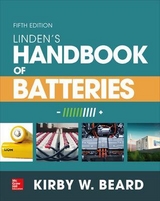
Linden's Handbook of Batteries
McGraw-Hill Professional (Verlag)
978-0-07-162421-3 (ISBN)
- Titel erscheint in neuer Auflage
- Artikel merken
Publisher's Note: Products purchased from Third Party sellers are not guaranteed by the publisher for quality, authenticity, or access to any online entitlements included with the product.
The most complete and up-to-date guide to battery technology and selectionThoroughly revised throughout, Linden's Handbook of Batteries, Fourth Editions provides authoritative coverage of the characteristics, properties, and performance of every major battery type. New information on emerging battery systems and their applications is included in this definitive volume. International experts offer unparalleled technical guidance on using leading-edge technologies, materials, and methods in new designs and products, and selecting the most suitable battery for a particular application. All of the in-depth data you need is contained in this comprehensive resource. The book will be useful to graduate students, battery researchers, applications engineers, and all others interested in the state-of-the-art in battery technology.
Linden's Handbook of Batteries, Fourth Edition covers:
PRINCIPLES OF OPERATION
PRIMARY AND SECONDARY BATTERIES
SPECIALIZED BATTERY SYSTEMS
FUEL CELLS AND ELECTROCHEMICAL CAPACITORS
Includes new chapters on:
Battery modeling
Battery electrolytes
Lithium-ion batteries
Battery selection for consumer electronics
Batteries for electric, hybrid, and plug-in hybrid vehicles
Batteries for electrical energy storage systems
Batteries for biomedical applications
Button cell batteries
Batteries for military and space applications, including reserve water-activated and reserve military batteries
Electrochemical capacitors
Thomas Reddy, Ph.D., is an Adjunct Assistant Professor in the Bio-Engineering Division of the Robert Wood Johnson Medical School of the University of Medicine and Dentistry of New Jersey, and a Visiting Scientist in the School of Engineering of Rutgers University. He was a leader in the development of Lithium Primary Batteries and served as a Vice President of Power Conversion, Inc, (currently Hawker Electrocell, Inc.) and Yardley Technical Products, Inc., and continues to act as consultant to Yardley.
Part 1: Principles of Operation; Chapter 1. Basic Concepts; Chapter 2. Electrochemical Principles and Reactions; Chapter 3. Factors Affecting Battery Performance; Chapter 4. Battery Standardization; Chapter 5. Battery Design; Chapter 6. Mathematical Modeling of Batteries; Chapter 7. Battery Electrolytes; Part 2: Primary Batteries; Chapter 8. An Introduction to Primary Batteries; Chapter 9. Zinc-Carbon Batteries--Leclanche and Zinc Chloride Cell Systems; Chapter 10. Magnesium and Aluminum Batteries; Chapter 11. Alkaline-Manganese Dioxide Batteries; Chapter 12. Mercuric Oxide Batteries;Chapter 13. Button Cell Batteries: Silver Oxide-Zinc and Zinc-Air Systems; Chapter 14. Lithium Primary Batteries; Part 3: Secondary Batteries; Chapter 15. An Introduction to Secondary Batteries; Chapter 16. Lead-Acid Batteries; Chapter 17. Valve-Regulated Lead-Acid Batteries; Chapter 18. Iron Electrode Batteries; Chapter 19. Industrial and Aerospace Nickel-Cadmium Batteries; Chapter 20. Vented Sintered-Plate Nickel-Cadmium Batteries; Chapter 21. Portable Sealed Nickel-Cadmium Batteries; Chapter 22. Nickel-Metal Hydride Batteries; Chapter 23. Nickel-Zinc Batteries; Chapter 24. Nickel-Hydrogen Batteries; Chapter 25. Silver Oxide Batteries; Chapter 26. Lithium-Ion Batteries; Chapter 27. Rechargeable Lithium Metal Batteries (Ambient Temperature); Chapter 28. Rechargeable Zinc/Alkaline/Manganese Dioxide Batteries; Part 4: Specialized Battery Systems; Chapter 29. Batteries for Electric and Hybrid Vehicles; Chapter 30. Batteries for Electrical Energy Storage Applications; Chapter 31. Batteries for Biomedical Applications; Chapter 32. Battery Selection for Consumer Electronics; Chapter 33. Metal/Air Batteries; Chapter 34. Reserve Magnesium Anode and Zinc/Silver Oxide Batteries; Chapter 35. Reserve Military Batteries; Chapter 36. Thermal Batteries; Part 5: Fuel Cells and Electrochemical Capacitors; Chapter 37. Introduction to Fuel Cells; Chapter 38. Small Fuel Cells; Chapter 39. Electrochemical Capacitors; Appendix A. Definitions; Appendix B. Standard Reduction Potentials; Appendix C. Electrochemical Equivalents of Battery Materials; Appendix D. Standard Symbols and Constants; Appendix E. Conversion Factors; Appendix F. Bibliography; Appendix G. Battery Manufacturers and R&D Organizations; Appendix H. Methodologies for Battery Failure and Analysis; Index
| Reihe/Serie | McGraw-Hill HANDBOOKS |
|---|---|
| Zusatzinfo | 450 Illustrations, unspecified |
| Sprache | englisch |
| Maße | 193 x 241 mm |
| Gewicht | 2130 g |
| Themenwelt | Technik ► Elektrotechnik / Energietechnik |
| ISBN-10 | 0-07-162421-X / 007162421X |
| ISBN-13 | 978-0-07-162421-3 / 9780071624213 |
| Zustand | Neuware |
| Haben Sie eine Frage zum Produkt? |
aus dem Bereich



